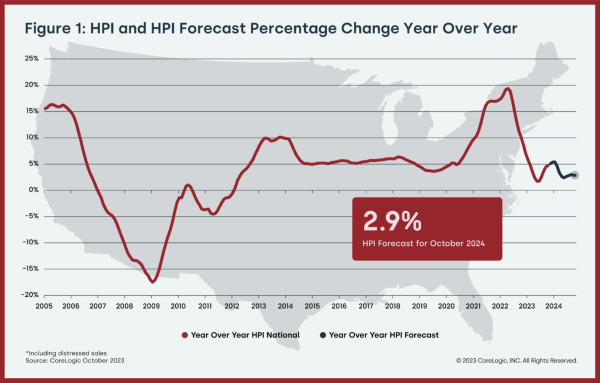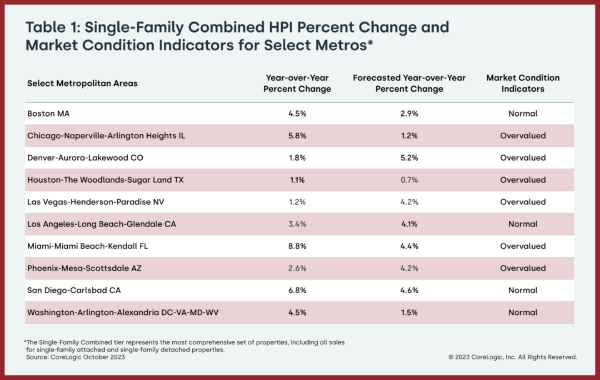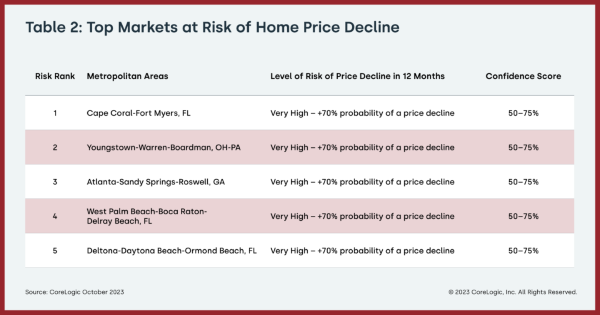CoreLogic: US Home Price Growth Continues Slow but Steady Increase in October

CoreLogic®, a leading global property information, analytics and data-enabled solutions provider, released the CoreLogic Home Price Index (HPI™) and HPI Forecast™ for October 2023.
- U.S. single-family home prices increased by 4.7% year over year in October, the 141st straight month of annual appreciation.
- CoreLogic projects that annual home price growth will relax to 2.9% by October 2024.
- Northeastern states again led the country for annual appreciation in October, while four Western states saw slight losses.
- The Miami metro area continued its lengthy run as the highest-appreciating major U.S. housing market in October, posting an annual gain of 8.8%.
U.S. single-family home price growth continued to increase modestly in October, posting a 4.7% year-over-year increase. On a regional level, the Northeast again showed the biggest price rebound. The top five states with the highest annual appreciation in October are in that area of the country, with growth ranging from 10.3% in Connecticut to 9.3% in Maine and New Hampshire. The Northeast could be enjoying renewed home price gains in part due to a largely hybrid American workforce, in which employees need to be relatively close to major urban areas to allow for commutes to the office a few times per week.
“Home price growth maintained its upward momentum in October, which continues to reflect gains from the strong spring season and contrasts with last year’s home price declines,” said Dr. Selma Hepp, chief economist for CoreLogic. “But even with high mortgage rates, October’s price gains line up with historical trends and speak to the strength of some potential buyers’ purchasing power, as they continue to outnumber available homes for sale. Metros that are seeing relatively stronger price gains are those with higher job growth, as well as those with an influx of higher-income, in-migrating households.”
Top Takeaways
- U.S. single-family home prices (including distressed sales) increased by 4.7% year over year in October 2023 compared with October 2022. On a month-over-month basis, home prices rose by 0.2% compared with September 2023.
- In October, the annual appreciation of detached properties (5%) was 1 percentage point higher than that of attached properties (4%).
- CoreLogic’s forecast shows annual U.S. home price gains slowing to 2.9% in October 2024.
- Miami posted the highest year-over-year home price increase of the country’s 20 tracked metro areas in October, at 8.8%. Detroit saw the next-highest gain (7.7%) followed by St. Louis (7.6%).
- Among states, Connecticut ranked first for annual appreciation in October (up by 10.3%), followed by New Jersey (up by 9.9%) and Rhode Island (up by 9.7%). Four states recorded year-over-year home price losses: Utah (-1.6%), Idaho (-1.4%), Montana (-0.5%) and Texas (-0.2%).
The next CoreLogic HPI press release, featuring November 2023 data, is scheduled to be issued on January 9, 2024, at 8 a.m. EST.



Methodology
The CoreLogic HPI™ is built on industry-leading public record, servicing and securities real-estate databases and incorporates more than 45 years of repeat-sales transactions for analyzing home price trends. Generally released on the first Tuesday of each month with an average five-week lag, the CoreLogic HPI is designed to provide an early indication of home price trends by market segment and for the Single-Family Combined tier, representing the most comprehensive set of properties, including all sales for single-family attached and single-family detached properties. The indices are fully revised with each release and employ techniques to signal turning points sooner. The CoreLogic HPI provides measures for multiple market segments, referred to as tiers, based on property type, price, time between sales, loan type (conforming vs. non-conforming) and distressed sales. Broad national coverage is available from the national level down to ZIP Code, including non-disclosure states.
CoreLogic HPI Forecasts™ are based on a two-stage, error-correction econometric model that combines the equilibrium home price—as a function of real disposable income per capita—with short-run fluctuations caused by market momentum, mean-reversion, and exogenous economic shocks like changes in the unemployment rate. With a 30-year forecast horizon, CoreLogic HPI Forecasts project CoreLogic HPI levels for two tiers — Single-Family Combined (both attached and detached) and Single-Family Combined Excluding Distressed Sales. As a companion to the CoreLogic HPI Forecasts, Stress-Testing Scenarios align with Comprehensive Capital Analysis and Review (CCAR) national scenarios to project five years of home prices under baseline, adverse and severely adverse scenarios at state, metropolitan areas and ZIP Code levels. The forecast accuracy represents a 95% statistical confidence interval with a +/- 2% margin of error for the index.
To read the original release, click here.
About Market Risk Indicators
Market Risk Indicators are a subscription-based analytics solution that provide monthly updates on the overall health of housing markets across the country. CoreLogic data scientists combine world-class analytics with detailed economic and housing data to help determine the likelihood of a housing bubble burst in 392 major metros and all 50 states. Market Risk Indicators is a multi-phase regression model that provides a probability score (from 1 to 100) on the likelihood of two scenarios per metro: a >10% price reduction and a = 10% price reduction. The higher the score, the higher the risk of a price reduction.
About the Market Condition Indicators
As part of the CoreLogic HPI and HPI Forecasts offerings, Market Condition Indicators are available for all metropolitan areas and identify individual markets as overvalued, at value or undervalued. These indicators are derived from the long-term fundamental values, which are a function of real disposable income per capita. Markets are labeled as overvalued if the current home price indexes exceed their long-term values by greater than 10% and undervalued where the long-term values exceed the index levels by greater than 10%.
About CoreLogic
CoreLogic is a leading provider of property insights and innovative solutions, working to transform the property industry by putting people first. Using its network, scale, connectivity and technology, CoreLogic delivers faster, smarter, more human-centered experiences that build better relationships, strengthen businesses and ultimately create a more resilient society. For more information, please visit www.corelogic.com.
Contact:
Robin Wachner – Media Contact – newsmedia@corelogic.com
Source: CoreLogic, Inc.

